Doctors use to prescribe Guinness to people because they thought it
promoted sociability, good eating and happiness! I guess their marketing
department picked up on that, too.
The Guinness Storehouse Tour is a popular stop for visitors when they're doing the
department picked up on that, too.
The Guinness Storehouse Tour is a popular stop for visitors when they're doing the
rounds in Dublin. David and I hadn't gone because we figured when company came,
they would want to go. As it turns out, we were right! Art and Mary had it on their
itinerary for day two in Dublin. Art was in "seventh heaven", as he would say.
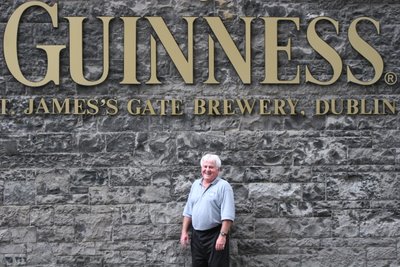
Art in front of St. James Gate -- more on what that is at the end.
Like a kid at camp! When we paid our entry fee, they gave us a souvenir...
It is a plastic piece with a drop of Guinness inside.

The tour was self guided - It showed you about all the stages of the
brewing process. They don't actually produce Guinness here. So,
you read signs and watch videos; There are also places to touch
barley and taste it after it's been malted. Pretty cool.
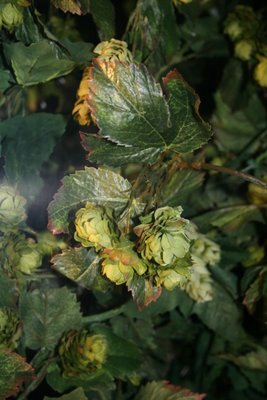
I had seen barley and things like that before, but
this picture is of hops. I had not idea what hops looked
like...But I do now! It was growing on this tall vine. They
said 'once upon a time', the only way to pick the top part
of the hops was for pickers to wear stilts! I'm sure they've
come up with a better way more recently.
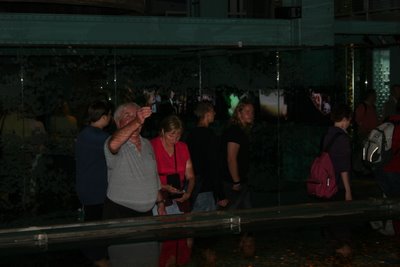
They had this fountain area where you could make a wish.
So, we all stopped to throw in a penny and whisper one to ourselves.
Art said his wish aloud -- clearly a wish-violation, he had to
go again.
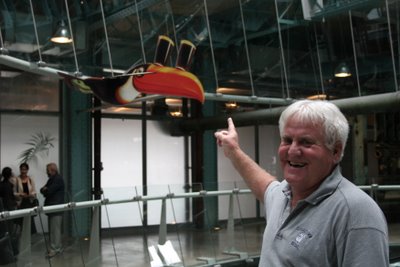
Art with the Guinness Toucan.
Guiness is coming out with some promotional beers...
a series of three. Guinness Toucan is the second one, out now.
I'm not a Guinness drinker. So, I haven't tried it, but Art did.

Just a little visual from the tour. They've incorporated a few
things like this to show you what might have been in the
actual brewhouse factory.

Here was something interesting we learned along the way...
Where The Guinness Book of World Records originated.
None of us had connected the book with the Guinness family.
Apparently, in autumn of 1951, Sir Hugh Beaver, then the
managing director of the Guinness Brewery, went on a hunting
trip. He and some of his mates got into a debate over what was
the fastest game bird in Europe. They had it narrowed down
between two birds, the Golden Plover and the Grouse, but
they were unable to confirm the winner through books.
Beaver figured there must be countless arguments like
theirs taking place each night in the 81,400 pubs across
Britain and Ireland. Again with no source that could settle
such debates once and forall, and he thought a book that
could do so might be quite popular.
Another Guinness employee, Christopher Chataway,
recommended his college friends, Norris and Ross McWhirter,
for the job. The brothers were in London running a fact-finding
agency. They were commissioned to write the first copy of the
book in 1954. As a marketing idea (but mostly for fun) they
printed and gave away 1,000 copies. That year, it went to the top
of the British bestseller list and went on to sell 70,000 copies
in the United States the following year.
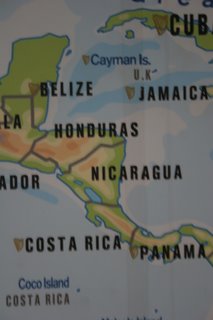
We thought of Marya while we were here!!
They have a huge world map showing all the
spots for Guinness distribution. I took a quick
pic of where Marya is in Nicaragua. We miss
you, Mar! (For those of you who don't know,
Marya is David's sister. She's a Peace Corps
Volunteer living in Nicaragua.)
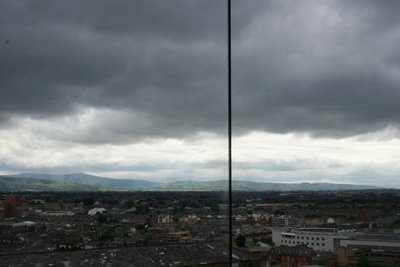
And now for what is easily the best part of the tour at
Guinness...The Observation Tower for tasting! The whole
thing was surrounded by huge glass windows, probably
offering one of the best available views of the city. You
can see (although, much better in person) how the city
melts into the countryside. It really gives you an appreciation
for the size of Dublin. It was neat to be up there. I think
we were on the 7th floor...maybe the 8th. I'm not sure.

You are offered a complimentary Guinness while
you enjoy the view. As busy as they are, they still
don't rush along the process of pouring it three-quarters
of the way, letting it settle and then topping it off.
I actually had my very first Guinness while we were
here! It was a half-pint, but it was my first Guinness
nonetheless.
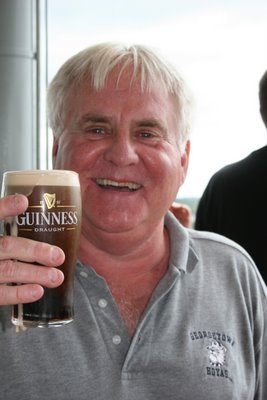
Art was so excited to get his nice, cold Guinness
from The Source!

That completes the tour, but I just thought I'd share a little info
about how the business got started and what the family has
done for Ireland. It's pretty good stuff...Inspiring, for sure.
Arthur Guinness was born in 1725. His father, Richard, was the
land steward for Arthur Price, the Archbishop of Cashal. One of
Richards responsibilities was to oversee the brewing of beer for
workers of the estate. Arthur Guinness helped his father with this
from time to time and began to understand the process.
In 1752 Arthur Price passed away, and when he did, he left
£100 to Arthur Guinness who invested that money to start his
own brewery with his brother, Richard. (They actually began in
Leixlip, which is two miles from where we live in Lucan and the
city where David is working with Intel.)
Years later, Arthur Guinness handed that brewery over to his
brother infull and went to Dublin to start a new and different kind
of brewery. He signed a lease on the St. James Gate Brewery
(the beginning of this post shows Art in front of the famous gate)
for 9,000 years at £45 per year. (Isn't that amazing?!)
The brewery was in bad shape at the time, but he invested all
kinds of money, time, ingenuity, and sheer will into it. It's turned
into an explosive business that's lasted and stayed strong all this
time. The success of the brewery has enabled the Guinness family
to give unabashedly to Dublin and Ireland. They've done a lot of
good for the city, and there are small tokens of appreciation to
Arthur Guinness found throughout it. For example, a statue of him
was erected in front of St. Patrick's Cathedral, an Episcopal Church,
for the money he donated so it could be restored and maintained.
By 1886, Guinness had become the largest brewery production
house in the world, producing 1.2 million barrels annually. In
the 1890s, they appointed people to travel oversees to be sure the
Guinness being served in other countries was of the same quality
as was being sold locally. They still do this today. At it's peak,
more than 4,000 people were directly employed at the St. James
Gate location. That's a lot of jobs and a lot of money sent into an
area when the country needed it most. And it all started with £100,
an idea and action.

Art in front of St. James Gate -- more on what that is at the end.
Like a kid at camp! When we paid our entry fee, they gave us a souvenir...
It is a plastic piece with a drop of Guinness inside.

The tour was self guided - It showed you about all the stages of the
brewing process. They don't actually produce Guinness here. So,
you read signs and watch videos; There are also places to touch
barley and taste it after it's been malted. Pretty cool.

I had seen barley and things like that before, but
this picture is of hops. I had not idea what hops looked
like...But I do now! It was growing on this tall vine. They
said 'once upon a time', the only way to pick the top part
of the hops was for pickers to wear stilts! I'm sure they've
come up with a better way more recently.

They had this fountain area where you could make a wish.
So, we all stopped to throw in a penny and whisper one to ourselves.
Art said his wish aloud -- clearly a wish-violation, he had to
go again.

Art with the Guinness Toucan.
Guiness is coming out with some promotional beers...
a series of three. Guinness Toucan is the second one, out now.
I'm not a Guinness drinker. So, I haven't tried it, but Art did.

Just a little visual from the tour. They've incorporated a few
things like this to show you what might have been in the
actual brewhouse factory.

Here was something interesting we learned along the way...
Where The Guinness Book of World Records originated.
None of us had connected the book with the Guinness family.
Apparently, in autumn of 1951, Sir Hugh Beaver, then the
managing director of the Guinness Brewery, went on a hunting
trip. He and some of his mates got into a debate over what was
the fastest game bird in Europe. They had it narrowed down
between two birds, the Golden Plover and the Grouse, but
they were unable to confirm the winner through books.
Beaver figured there must be countless arguments like
theirs taking place each night in the 81,400 pubs across
Britain and Ireland. Again with no source that could settle
such debates once and forall, and he thought a book that
could do so might be quite popular.
Another Guinness employee, Christopher Chataway,
recommended his college friends, Norris and Ross McWhirter,
for the job. The brothers were in London running a fact-finding
agency. They were commissioned to write the first copy of the
book in 1954. As a marketing idea (but mostly for fun) they
printed and gave away 1,000 copies. That year, it went to the top
of the British bestseller list and went on to sell 70,000 copies
in the United States the following year.

We thought of Marya while we were here!!
They have a huge world map showing all the
spots for Guinness distribution. I took a quick
pic of where Marya is in Nicaragua. We miss
you, Mar! (For those of you who don't know,
Marya is David's sister. She's a Peace Corps
Volunteer living in Nicaragua.)

And now for what is easily the best part of the tour at
Guinness...The Observation Tower for tasting! The whole
thing was surrounded by huge glass windows, probably
offering one of the best available views of the city. You
can see (although, much better in person) how the city
melts into the countryside. It really gives you an appreciation
for the size of Dublin. It was neat to be up there. I think
we were on the 7th floor...maybe the 8th. I'm not sure.

You are offered a complimentary Guinness while
you enjoy the view. As busy as they are, they still
don't rush along the process of pouring it three-quarters
of the way, letting it settle and then topping it off.
I actually had my very first Guinness while we were
here! It was a half-pint, but it was my first Guinness
nonetheless.

Art was so excited to get his nice, cold Guinness
from The Source!

That completes the tour, but I just thought I'd share a little info
about how the business got started and what the family has
done for Ireland. It's pretty good stuff...Inspiring, for sure.
Arthur Guinness was born in 1725. His father, Richard, was the
land steward for Arthur Price, the Archbishop of Cashal. One of
Richards responsibilities was to oversee the brewing of beer for
workers of the estate. Arthur Guinness helped his father with this
from time to time and began to understand the process.
In 1752 Arthur Price passed away, and when he did, he left
£100 to Arthur Guinness who invested that money to start his
own brewery with his brother, Richard. (They actually began in
Leixlip, which is two miles from where we live in Lucan and the
city where David is working with Intel.)
Years later, Arthur Guinness handed that brewery over to his
brother infull and went to Dublin to start a new and different kind
of brewery. He signed a lease on the St. James Gate Brewery
(the beginning of this post shows Art in front of the famous gate)
for 9,000 years at £45 per year. (Isn't that amazing?!)
The brewery was in bad shape at the time, but he invested all
kinds of money, time, ingenuity, and sheer will into it. It's turned
into an explosive business that's lasted and stayed strong all this
time. The success of the brewery has enabled the Guinness family
to give unabashedly to Dublin and Ireland. They've done a lot of
good for the city, and there are small tokens of appreciation to
Arthur Guinness found throughout it. For example, a statue of him
was erected in front of St. Patrick's Cathedral, an Episcopal Church,
for the money he donated so it could be restored and maintained.
By 1886, Guinness had become the largest brewery production
house in the world, producing 1.2 million barrels annually. In
the 1890s, they appointed people to travel oversees to be sure the
Guinness being served in other countries was of the same quality
as was being sold locally. They still do this today. At it's peak,
more than 4,000 people were directly employed at the St. James
Gate location. That's a lot of jobs and a lot of money sent into an
area when the country needed it most. And it all started with £100,
an idea and action.

No comments:
Post a Comment